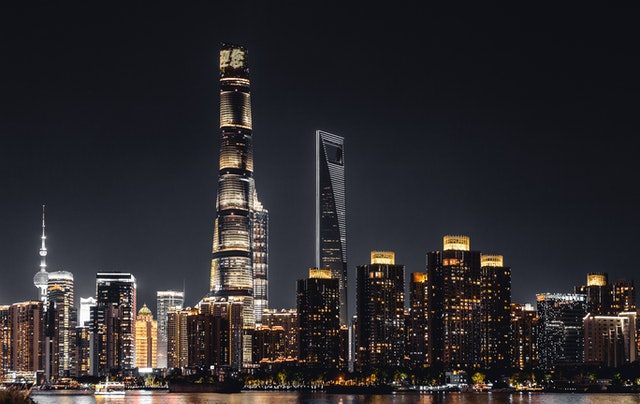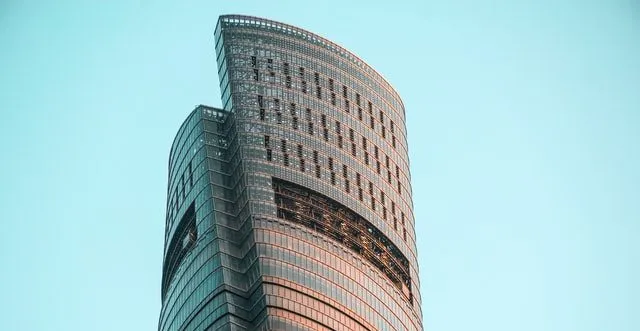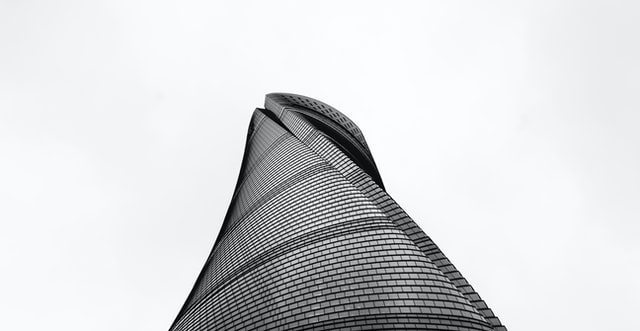The Shanghai Tower officially opened its doors to the public in 2016. It heralded the dawn of environmentally-friendly buildings in China. Any talk of the Shanghai Tower is bound to be punctuated by superlatives.
Although the Burj Khalifa is taller, its topmost floor stands 1,917 feet off the ground. On the other hand, the top floor of the Shanghai Tower is at 1,927 feet. Additionally, the tallest building in China has an observation deck 1,841 feet above the ground, making it the highest.
The Shanghai Tower never runs short of superlatives. It has the quickest elevators in the world. These elevators will get you to the top of the building at up to 50 miles an hour. Few cities have faster speed limits.
The Chinese government owns the Shanghai Tower. In 2020, 57% of China’s energy comes from burning coal. But with new goals of creating more sustainable energy consumption, it is determined to prove its commitment to environmental protection. Green building technology is one of the ways they intend to change their relationship with the environment. The Shanghai Tower marked a bold first step.
Is The Shanghai Tower The Most Sustainable Skyscraper?
The Shanghai Tower is the most sustainable supertall skyscraper. It utilizes technologies including smart sensors, wind turbines, rainwater harvesting, and energy-efficient HVAC systems. It has been awarded the LEED Platinum certification.

How Is The Shanghai Tower A Sustainable Skyscraper?
In all stages of its construction, the developers prioritized environmental friendliness. The company behind its design goes as far as calling it the greenest super tall building. Despite its unique design, most of its parts ensure it is as environmentally friendly as possible. What makes the tower one of the greenest buildings?
Shape Of The Shanghai Tower
The shape of the Shanghai Tower has the most notable impact on its sustainability. The building is a triangle that twists by 120 degrees from the bottom as you move upwards. Also, it is much wider at the base than at the tip.
The benefit of this shape is a wind load reduction of up to 24% compared to skyscrapers of the same height. The reduced wind load enabled the contractors to use only 75% of the structural steel a traditional building would need. Additionally, its rounded corners help it withstand rainstorms without requiring reinforcement.
Overall, the design choices of the Shanghai Tower reduced the costly materials required by at least 50 million dollars.
Double-Skin Facade On The Shanghai Tower
The surface of the Shanghai Tower consists of two layers of glass. The outer glass is fully laminated to bring in as much natural light as possible while reducing heat. Therefore, the double-skinned facade also reduces the cooling cost of the Shanghai Tower.
Natural light reduces the building’s power consumption while improving its occupants’ emotional well-being. Additionally, in between the two layers of glass is a landscaped atrium where the occupants can escape to be close to nature.
Shanghai Tower Climate Control System
Though the tower has excellent passive climate control, it still needs artificial heating and cooling. First, the building uses different sensors to track the temperature and available light. It also has carbon monoxide sensors to turn on the garage fans. All these sensors work in tandem to minimize the use of artificial air conditioning.
The Shanghai Tower has a variable air volume A/C system. It self-regulates based on the readings it gets from the sensors.
Electricity Generation Using Wind Turbines
The Shanghai Tower has more than 200 wind turbines installed on the roof. At 1,900 feet, there is more than enough wind to generate electricity. These turbines generate more than 1-gigawatt hours of electricity per year. It keeps the lights going and serves other non-essential parts of the building to complement the grid-based electricity.
Location Of Water Tanks, Chillers, And Treatment Plants
The water storage tanks in the Shanghai Tower are carefully positioned to improve water pressure and reduce pumping costs.
Water Control Valves In The Shanghai Tower
The Shanghai Tower has the highest number of water control valves of any building. The 6,700 valves in the building make the tower’s HVAC system one of the most efficient in the world.
Valves automatically regulate the pressure and temperature of water in the piping system that is many miles long. People in the building get good water pressure and temperature regardless of where they are.
The Shanghai Tower uses more than half of its power consumption on heating. Therefore, the control valves help save up to 20% of this energy. The intelligent water management system by Danfoss ensures that no pump, compressor, or fan ever runs faster than necessary.
Rain Water Harvesting
The top of the Shanghai Tower is a rainwater harvesting zone. Harvested rainwater irrigates the greenery in the building and also goes into the underground wash area.
In addition to harvesting water, the building reclaims water from the hotels for watering and use in toilets. Recycling and water harvesting are not enough, though. All faucets and toilets installed in the building save water with efficient smart technology.
These combined water-saving efforts reduce the water requirement of the Shanghai Tower by more than 50%.

How Are Developers Making Supertall Building Construction Sustainable?
People used to think that skyscrapers would never be green. The Shanghai Tower proved the critics wrong. It uses numerous environmentally-friendly construction and maintenance techniques. Which other eco-friendly tactics are developers using?
Sourcing Building Materials Locally
The transportation of materials to construction sites harms the environment. Building developers have now begun to prefer locally-sourced materials during construction. One of the first high-rise buildings to adopt this policy is the Bank Of America Tower, one of the greenest modern skyscrapers. More than 40% of its building materials were locally-sourced.
Green Buildings, Literally
We are not talking about green paint, no. Some skyscrapers have introduced plants throughout the structure. One of these buildings, the Singapore Green Tower, has plants throughout to reduce its carbon footprint. The greenery also creates a relaxing environment to counteract the overwhelming appearance nature of skyscrapers.
Another great example is the Oasis Hotel Downtown in Singapore. The building has more than 21 species of vines and climbers that create a home for birds and other small animals. The plants growing on the building cover a much larger area than the building’s footprint.
The Bosco Verticale of Milan takes the cake by incorporating an unprecedented amount of greenery. The building has more than 800 trees and 14,000 plants spread around its balconies.
Vertical Farms in Skyscrapers
Supertall buildings like the Shanghai Tower can take advantage of their height to grow food. The UN estimates that by 2050, more than 80% of the population will live in urban cities.
The greenest way to feed these people is to grow food closer to where they live. The only drawback of vertical farming is how dependent it is on technology.
For instance, you could lose the food in hydroponic gardens if the power goes out.
Do We Need Sustainable Buildings?
Buildings contribute a lot to the world’s energy waste. However, we cannot continue with the wasteful ways we used to design and manage them. Sustainable buildings are the new normal in the construction industry. What are the benefits and drawbacks of these buildings?
Benefits of Sustainable Buildings
1 | Sustainable Buildings Are Worth More Money
Sustainable buildings like the Shanghai Tower can use more money to construct than traditional buildings. However, their final value is worth up to 7 percent more. Companies that put up these buildings can quote higher budgets because the value of the building will offset the additional cost.
2 | Demand for Space In The Building Is Higher
Peoples’ awareness of the dire state of the environment has increased dramatically. Therefore, they want to associate themselves with companies that are conscious of environmental protection. It is easier to get tenants to rent space in a green building like the Shanghai Tower.
The reputation of the building owner also improves when they add a green building to their portfolio.
3 | Lower Operating Cost
Even though a green building might cost more to build, the lowered operating cost offsets it.
According to the European Commission, sustainable building technologies save up to 450 billion dollars of energy consumption per annum.
In addition to lower power costs, the buildings also reduce the wastage of other resources like water.
4 | They Contribute to Social Well-Being
The world green building council refers to a Harvard study that showed a 101% higher cognitive score for people who work in green buildings could be achieved. Additionally, these employees sleep an average of 46 more minutes per night. Finally, the better air quality of green buildings improves the productivity of their occupants.

Disadvantages of Green Buildings
The benefits of sustainable buildings like the Shanghai Tower far outweigh their drawbacks. However, they do have some off-putting drawbacks. These include:
- High initial investment. Green buildings are appealing because of their benefits down the road. However, you cannot ignore the high level of initial investment they require.
- Difficulty sourcing materials. Green buildings use unconventional building techniques and materials. Sometimes it can be challenging to source these materials.
- They take longer to build. Green buildings are more complex. Therefore, they take longer to finish compared to traditional buildings.
- Shortage of skilled workers. The green building industry is relatively new. As a result, finding experienced workers to help build them can be challenging.
Conclusion
The Shanghai Tower changed many peoples’ opinions about whether super-tall buildings could be green. It answered many skyscraper critics, but there are still challenges facing buildings of its kind. For instance, it is unclear whether they can bridge the efficiency gap between them and shorter structures. Fortunately for the Shanghai Tower, some cities don’t have the space for low-rise buildings.
If you want to learn more about PropTech, Smart Buildings and Sustainability in the Commercial Real Estate Market, feel free to take a look at our other articles.

